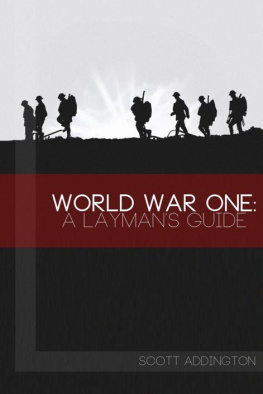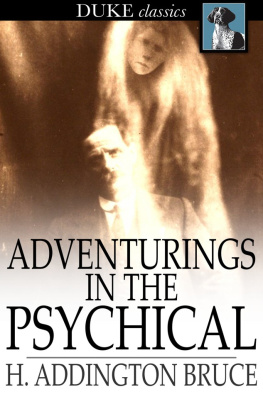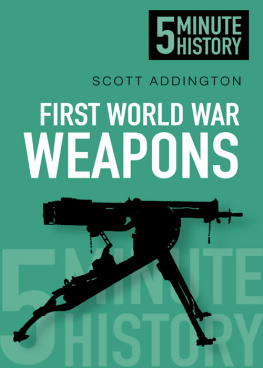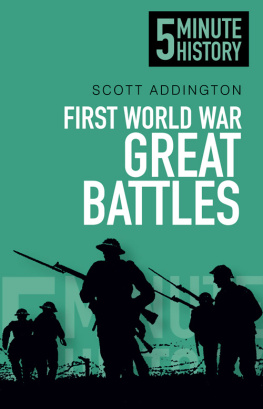Addington - World War One : a laymans guide
Here you can read online Addington - World War One : a laymans guide full text of the book (entire story) in english for free. Download pdf and epub, get meaning, cover and reviews about this ebook. City: Place of publication not identified, year: 2012, publisher: [S. Addington], genre: History. Description of the work, (preface) as well as reviews are available. Best literature library LitArk.com created for fans of good reading and offers a wide selection of genres:
Romance novel
Science fiction
Adventure
Detective
Science
History
Home and family
Prose
Art
Politics
Computer
Non-fiction
Religion
Business
Children
Humor
Choose a favorite category and find really read worthwhile books. Enjoy immersion in the world of imagination, feel the emotions of the characters or learn something new for yourself, make an fascinating discovery.
World War One : a laymans guide: summary, description and annotation
We offer to read an annotation, description, summary or preface (depends on what the author of the book "World War One : a laymans guide" wrote himself). If you haven't found the necessary information about the book — write in the comments, we will try to find it.
World War One : a laymans guide — read online for free the complete book (whole text) full work
Below is the text of the book, divided by pages. System saving the place of the last page read, allows you to conveniently read the book "World War One : a laymans guide" online for free, without having to search again every time where you left off. Put a bookmark, and you can go to the page where you finished reading at any time.
Font size:
Interval:
Bookmark:
World War One : A Laymans Guide
by
Scott Addington
Scott Addington 2012
All rights reserved
By the same author:
Heroes of the Line
There is one person to blame for yet another history on the First World War, his name is Duncan and he is a tattooist from Area51 tattoo studio in Basingstoke. He is responsible for the tattoo I have on the inside of my lower right arm. The ink in question depicts WW1 soldiers going over the top, it is a very famous image taken from a still of a movie made at the time. Nothing unusual in this I guess, given my background and interest in this particular phase of world history.
What is slightly more unusual is the fact that, when I wear short sleeves, I get stopped several times a day by complete strangers who want to talk about my tattoo. The conversation typically goes something like this: (Stranger) Hey I love your tattoo; I have not seen anything like that before
(Me) Thank you, yes I guess it is pretty unique, I havent seen anyone with a similar design
(Stranger) What is it exactly?
(Me) It is depicting British soldiers going over the top during WW1
(Stranger) That is amazing. I think my fought in the First World War. I dont really know much about what he did though. Its a shame; I should really find out a bit more.
(Me) So why dont you then? There are hundreds of books on WW1, pick a couple up and get reading!
(Stranger) Yeah, I should, but all the books I have seen look too and I just dont have the time to read anything these days, life is so busy!
So, it seems that despite the plethora of literature that has already been written on the First World War, there is still a large number of people (in the south of England at least) that would like to know more but for one reason or another think that the majority of existing literature is not written for them.
T his got me thinking.
I am not a historian, and for many that could be a big problem, because I do not have the intimate knowledge of the subject that an academic heavyweight would. But wait. Perhaps that isnt such a bad thing after all. Perhaps something that was written, not by an academic, but by an ordinary Layman would work here; using very short, sharp chapters that could take people who have little or no prior knowledge of the First World War through the main areas of the conflict to give them at least a passing knowledge of the more salient points. It would have to be written in a more conversational style and must be written in a way that can succinctly describe the main points of a serious piece of military history, not in 900 pages, but in 900 words. Something that could be dipped in an out when time permits, but didnt mean you had to re-read the last five pages to try and remember where you had originally got up to.
Here is that something. It doesnt pretend to be academic in nature, ( think of it more like a conversation over a pint), it doesnt pretend to be the last word on the subject, it doesnt pretend to cover everything in exhaustive detail, it is unashamedly bias towards the Western Front and it hasnt uncovered anything new or ground breaking. Indeed, people who hold a decent knowledge of the subject should perhaps walk away and read something else as you are not the intended audience. It does however try to give a new spin on current content and thoughts around the First World War and deliver it in a sharp, easy-to-dip-in-and-out way in an effort to make what can be a very daunting subject easier to digest and understand, especially for people who are reading about the subject for the first time.
Welcome then, to The First World War: A Laymans Guide .
Contents:
In 1892, two of Germanys largest military rivals, France and Russia, joined hands and signed an alliance that left Germany feeling a little well, threatened. If anything kicked off with either country, Germany would be facing a war on two fronts very quickly, which, lets be honest, was not an appealing prospect.
So, the German military brains got thinking on how best to deal with any future issues that could arise due to this new alliance and in 1899 Kaiser Wilhelm II approved the first draft of their master plan. Conjured up by Count Alfred von Schlieffen, it was basically a pre-emptive strike on France if and when things turned a bit naughty with Russia. The basic thinking was this: If a war was called it would take both France and Germany about fifteen days to be ready to fight a decisive battle, however it would take the Russians about six weeks to be ready for a fight, so in theory that gave Germany six weeks to kill off the French, get back to Germany and prepare their eastern front for the Russian attacks.
Piece of Cake.
Of course, with all the French fortresses dotted around the Franco-German border, such as those at Verdun, it would be unlikely such a quick victory would be attained in a head on assault. Switzerland wasnt really a viable route into France either due to its mountainous and difficult terrain, but Belgium, with its wide flat countryside, offered a very real possibility for the likely invasion route. Belgium was neutral, so going through her would technically be illegal, but which war was ever 100% above board? And so it was decided. A massive invasion of Belgium would brush their army aside as the German forces marched south into France and around the back of Paris, sweeping through the capital and back towards the border, encircling the French Army en route. The attack would be swift and calculating. So fast, in-fact, that Great Britain, the historical protector of Belgian neutrality, would have barely finished a cup of tea before the Germans were partying in Paris. Or at least, that was the plan.
Between 1899 and 1906 this master plan crystallised into a very precise order of battle. Thirty-four divisions, backed up by heavy artillery , would invade Belgium and move down into France towards Lille. Meanwhile a smaller force would hold onto the Franco-German border in case the French decided that the best form of defence was attack. These frontier armies would then slowly retreat into Germany, pulling the French with them, leaving a big hole behind, which the invading forces would fill, surround the attacking French forces and destroy them. Once the French were out of the way the focus could then switch to the east.
In 1906, von Schlieffen was replaced as Chief-of-Staff by Field Marshall Helmuth von Moltke. When it was clear that war was imminent in the summer of 1914, von Moltke set the plan in motion. However, he made one small, but ultimately costly, change to the original plans; he was very nervous about the build-up of French forces on their border and took significant troops and resources away from the northern wing of his forces and placed them opposite the French.
In the end, when the go button was ultimately pressed, this would prove very costly.
28th June 1914. Archduke Franz Ferdinand had an appointment in Bosnia to oversee some army manoeuvres. He didnt expect to be welcomed with open arms on this trip, the Archduke was the heir to the throne of the ruling Austro-Hungarian Empire, and a large percentage of the Bosnian population were unhappy at Austrian dominance, instead favouring a union with Serbia. Despite being royally despised, the Archduke was looking forward to the trip and his party arrived by train at around 10am.
At 10.10am when the six car possession passed the central police station, Nedjelko Cabrinovic, a member of a local terrorist group called Black Hand hurled a hand grenade at the Archdukes car. The driver accelerated when he saw the object flying towards him and the grenade exploded under the wheel of the next car. Two of the occupants, Eric von Merizzi and Count Boos-Waldeck were seriously wounded. About a dozen spectators were also hit by bomb splinters.
Font size:
Interval:
Bookmark:
Similar books «World War One : a laymans guide»
Look at similar books to World War One : a laymans guide. We have selected literature similar in name and meaning in the hope of providing readers with more options to find new, interesting, not yet read works.
Discussion, reviews of the book World War One : a laymans guide and just readers' own opinions. Leave your comments, write what you think about the work, its meaning or the main characters. Specify what exactly you liked and what you didn't like, and why you think so.











